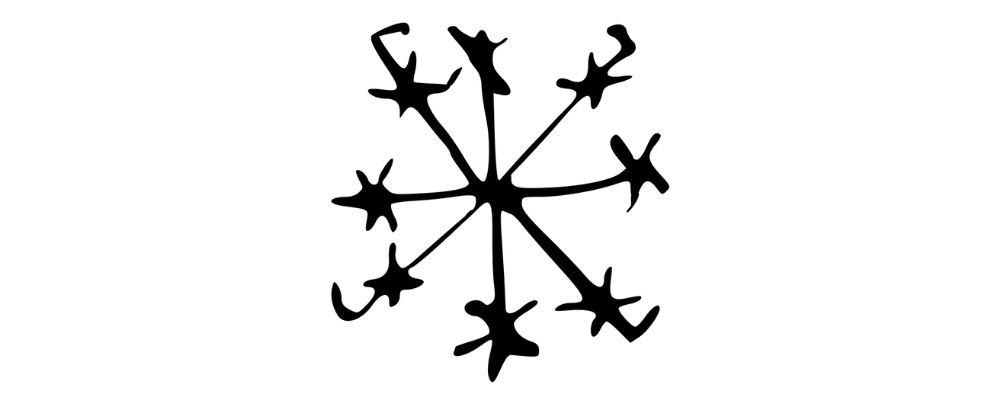The Vikings believed that the runes were not a created alphabet but a fundamental part of the fabric of the universe discovered by Odin and shared with mankind. Used correctly, they could magically shape the world.
We have written previously on the blog about the historical development of the runes and what we know about how the runes were used in the pre-Viking and Viking ages. Though, admittedly, very little is known about the Viking age itself as very few runic inscriptions survive, and written accounts are all given by outsiders from a later period. We have also written about how the runes have been revived for modern runic rituals.
One of the elements of Viking runic magic that fascinates many of us most are the magical runic staves, called Galdrastafir, recorded in the Icelandic grimoires. We often point to these as examples of Viking rune magic.

Do the Galdrastafir Reflect Viking Age Rune Magic?
But it is essential to realize that the rune magic recorded in these grimoires dates from at least 500 years after the Viking world had fully converted to Christianity. There are several grimoires that date from the 15th to 19th century, but mainly from the 18th century, and they record hundreds of magical staves.
The context of the grimoires is reflected in the texts, which are modeled on Christian Renaissance occult texts and refer to Norse gods and Christian saints side by side.
It is extremely difficult to know how closely the magical runic staves recorded in the Icelandic grimoires reflect how rune magic was conducted in the Viking age.
The Galdrastafir work by stacking the runes into symbols called staves that have a specific magical purpose. The grimoires record the symbol and describe when and how they should be inscribed to be effective.
There is some evidence for rune stacking in the pre-Viking age, in the migration period into Scandinavia, when the Elder Futhark runic alphabet was still used (Young Futhark was used in the Viking age). We often see runes, such as the Tiwaz rune associated with the god Tyr, inscribed repeatedly for no apparent reason, perhaps as a kind of magical invocation.
Many scholars also believe that the runic word ALU, which often appears in proto-Viking inscriptions, may be a runic configuration for protection rather than a word per se.
These examples may reflect the idea of stacking runes to create magical talismans. But interestingly, there is no evidence for these practices during the Viking age itself.
Therefore, when we talk about the Galdrastafir, it is crucial to know that we are talking about Norse runic magic but that the practice doesn’t belong to the Viking age itself. Of course, that doesn’t make these magical runic staves any less interesting.
Let’s take a closer look at some of the runic staves that survive in the grimoires, what they were used for and how they worked. This time we will skip over Aegishjalmur (the Helm of Awe) and Vegvisir (the Norse Compass) because they already have dedicated posts on our blog. Let’s look at some of the lesser known symbols.

Draumstafur
Draumstafur is the dream rune, which promises to allow you to dream of your heart’s desire. But this rune is about more than inducing sweet dreams. In the Norse world, dreams were considered prophetic. If you could take control of your dreams and steer them in a desired direction, perhaps you could take control of your destiny.
According to one manuscript, the rune should be written onto silver or white leather on St John’s night, a Christian reference to Midsummer’s eve. Place it under your pillow, and when you sleep, your dreams will feature your unfulfilled desires.
Another manuscript suggests carving it on a red spruce and putting it under your own pillow, or on “man killing oak” and putting it under someone else’s pillow without them knowing to take control of their dreams.

Holastafur
Holastafuur is described specifically as a rune for opening hills, but it probably means that it is used for communicating with the dead. There are many afterlives in Norse culture, but a common belief was that the dead moved under a hill, where they lived largely the same life as when they were alive. This is probably why burial mounds were often used as resting places.
The Holastafur rune could allow you to open a hill in order to be able to communicate with the dead.

Nabrokarstafur
Necromancy is not unknown among the symbols included in the grimoires. The Nabrokarstafur rune is used to make nabrok, which are pants made from the skin of a dead man that are capable of producing unlimited money.

Lucky Runes
Vegvisir, also known as the Norse Compass, is probably the most well-known runic stave for guidance and protection. According to the grimoires, if you use the symbol, you will never lose your way, even if you don’t know where you are going. It is specifically designed for use on the high seas. Several similar guiding and protecting runes are recorded in the grimoires.
Lukkastafir is a rune for luck. “Whosoever bears these staves on him will not meet with mishaps on sea and land.” Whether this means carrying a physical representation of the stave or drawing it on your skin is unclear. We know that the Vikings used tattoos.
Salomons Insigli, named for King Solomon and which looks very much like the Helm of Awe, should be carried for self-defense. Meanwhile Davids Insigli, named for King David, can be carried to protect against evil spirits. These are clear examples of Christian and older Pagan ideas intersecting in these grimoires.

Fear and Strength Runes
Runes to strike fear in the heart of an enemy is another common theme. Again, Aegishjalmur, also known as the Helm of Awe, is the most well-known rune in this context. As well as granting success in battle, it would strike fear in the heart of your enemies.
Ottastafur is another fear rune. Scratch the symbol on an oak tablet and throw it at the feet of your enemy to make them afraid. To be fair, it would be pretty scary to know that the person in front of you is actively cursing your existence.
But Aegishjalmur is also a strengthening symbol, as is Herdslustafir. Carry this symbol on your left chest and it will strengthen your mind.

Lasabrjotur
According to the grimoires, this is a symbol for breaking locks. This is certainly an example of a more modern runic stave since there is no evidence for the widespread use of locks in the Viking world.
Draw the symbol onto a lock and blow upon it, and this will summon trolls and demons to grab the lock and crack it.

Dreprun
Dreprun is known as the killing rune, but it is more about killing someone’s livelihood than their person. Put this symbol on your enemy’s horse trail, and they will lose all their livestock.

Wrestling Runes
This is one that MMA fighters wish they knew about. Draw the Gapaldur rune on your right heel and the Ginfaxi rune on your left toes to ensure victory in a wrestling match.

Fengur
The Fengur rune is used to “catch” a girl, specifically to get her pregnant, presumably forcing her to marry you. The symbol should be drawn onto a piece of cheese and given to the girl to eat. Ladies, be wary of men bearing cheese!

Thorshamar
This stave is literally called the “Thor’s Hammer” rune, and it is to be used by wizards and magic workers rather than others who might use a rune for luck or guidance. The rune is often used to expose magic or deceit. The grimoires specifically say that it can expose a thief. But cryptically, the text also says that wizards can use it to “do other magic”.

Thief Runes
Several specific runes are recorded for exposing thieves, suggesting this was a major issue in Iceland in the 18th century.
Thjofastafur should be put under the doorstep of your enemy. He will recoil when he passes the threshold if he has stolen from you. A similar symbol can be scratched onto the bottom of the plate of a suspected thief to expose them when they try to eat.
Other Thjofastafur runes can be scratched on to a man killing oak and kept in your hand to help you detect a thief. Or you can scratch a similar symbol onto birch wood and put it beneath your pillow so that you will see the thief in your dreams.

Healing Runes
It is noticeable that there are surprisingly few staves dedicated to healing within the grimoires. For example, one grimoire from around 1800 that includes 187 spells, including runic staves, contains only two spells for healing.
This might reflect Norse ideas about fate and death, and that while some things in life can be changed, the hour of one’s death is not one of them. Read our post on Viking ideas of destiny here.
Other Types of Magic
While magical runic staves are one of the most interesting forms of magic included in the Icelandic grimoires. The grimoires contain a wide variety of spells, far too complex to discuss here. But let’s look at a few examples.
So that an enemy cannot target you with magic, collect enough of their hair to make a band that can be tired into three knots. As long as the band is preserved, their spells can do no harm.
If you want to ensure that someone sleeps, take the teeth and a bone from the left arm of a dead person and place it under their pillow. They will not awaken until you remove these objects. Whoever wrote the manuscripts notes that he has tested this method himself.
If you want to gain a friend for life, forge two silver rings and place them for nine nights in the nest of a wagtail or sparrow. Take one each, and as long as you both have them, loyalty will continue in your friendship. But you can never tell them that you have cast the spell. The grimoire says this spell also works for keeping a good woman.
To make an invisibility cloak, you should find a totally black dog with no white hair, kill it, and extract its heart. Take a spruce branch and split it so that you can place the heart in the gap. Bury this in the earth where wild and cultivated land meet and leave it there for nine nights before St John’s day. On St John’s Day, when you dig up your offering, you will find a stone. Carry it with you to become invisible.

Icelandic Magic
Icelandic magic is a fascinating topic well worth learning about. But it is important to remember that the knowledge collected in the surviving grimoires dated to Medieval Iceland, which was a Christian society, and that the magic recorded in the texts is clearly influences by both folk practices from the area and Christian Renaissance magic. Unpicking one from the other is a challenging task.
If you love Viking rune magic, why not check out some of the runic pieces in the VKNG collection.








